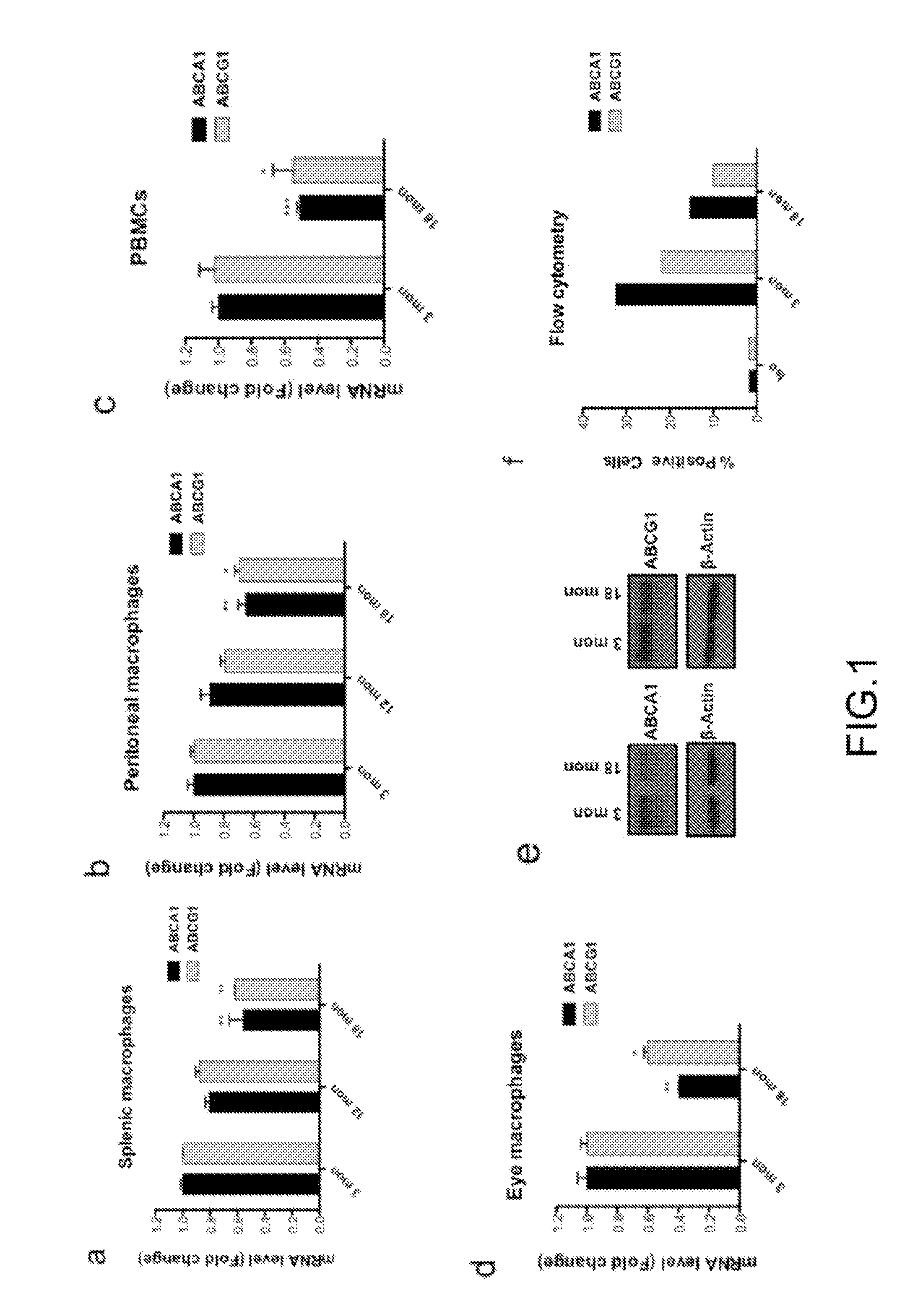Inhibition of choroidal neovascularization
a choroidal neovascularization and choroidal technology, applied in the direction of genetic material ingredients, drug compositions, peptide/protein ingredients, etc., can solve the problems of unstable hdl, conflicting data regarding the association between serum hdl and amd, and plateauing efficacy, so as to reduce the inability to efflux cholesterol from the intracellular space
- Summary
- Abstract
- Description
- Claims
- Application Information
AI Technical Summary
Benefits of technology
Problems solved by technology
Method used
Image
Examples
example 1
[0082]This example illustrates effects of age on cholesterol efflux. To determine whether age altered cholesterol efflux in macrophages, we analyzed the expression patterns of ABCA1 and ABCG1 in these cells. Quantitative analysis of gene expression by real time PCR demonstrated an age-associated reduction in levels of ABCA1 and ABCG1 expression in splenic, peritoneal and eye macrophages and PBMCs (FIG. 1a-d). Analysis of ABCA1 and ABCG1 protein levels in peritoneal macrophages isolated from either young (18 months) mice by western blotting as well as flow cytometry confirmed that reduced gene expression of ABCA1 and ABCG1 with age translated to reduced protein expression (FIG. 1e-f).
[0083]Because of the critical role of ABC transporters in lipid metabolism in macrophages, we examined whether the age-associated decrease of ABCA1 and ABCG1 altered the intracellular lipid load within macrophages and influenced formation of foam cells. Thioglycollate elicited young or old peritoneal mac...
example 2
[0087]This example illustrates that Abca1 [[, not Abcg1,]] depletion affects macrophage regulation of vascular endothelial cell proliferation and pathological angiogenesis.
[0088]To determine the contribution of individual ABC transporters in age-associated dysfunction of macrophage cholesterol homeostasis, we investigated the effects of selective Abca1 or Abcg1 deletion on effector function. Recent studies have demonstrated that macrophage polarization can play a pivotal role in determining their ultimate effector functions including their ability to regulate angiogenesis (Macrophages Inhibit Neovascularization in a Murine Model of Age-Related Macular Degeneration. PLoS Med 3(8): e310. doi:10.1371 / journal.pmed.0030310 2006; Kelly, J., et al., Senescence regulates macrophage activation and angiogenic fate at sites of tissue injury in mice. J. Clin. Invest. 117, 3421-3426, 2007; Mosser, D. M. The many faces of macrophage activation. J. Leukoc. Biol. 73, 209-212, 2003; Mantovani, A., e...
example 3
[0091]This example illustrates that a cholesterol-rich diet accelerates a senescent macrophage phenotype.
[0092]As shown in FIG. 2, ABCA1 / G1 transporters within macrophages regulate intracellular cholesterol efflux. We next investigated the effect of chronic dietary lipid / cholesterol burden on macrophage function using diet-induced obesity (DIO) mice as a model of high fat / cholesterol fed mice. Quantitative analysis of intracellular cholesterol content demonstrated that DIO macrophages had significantly higher levels of total cholesterol compared to age-matched controls at both 3 and 6 months of age (FIG. 3e). To determine whether high fat / cholesterol stress altered the ability of DIO macrophages to regulate vascular proliferation, we incubated young DIO macrophages with HMVECs and assessed their proliferation. DIO macrophages were unable to inhibit HMVECs proliferation (FIG. 3f). In addition, DIO macrophages demonstrated an impaired ability to regulate CNV in vivo (FIG. 3g-h) indica...
PUM
| Property | Measurement | Unit |
|---|---|---|
| light density fraction | aaaaa | aaaaa |
| thick | aaaaa | aaaaa |
| real time qPCR | aaaaa | aaaaa |
Abstract
Description
Claims
Application Information
 Login to View More
Login to View More - R&D
- Intellectual Property
- Life Sciences
- Materials
- Tech Scout
- Unparalleled Data Quality
- Higher Quality Content
- 60% Fewer Hallucinations
Browse by: Latest US Patents, China's latest patents, Technical Efficacy Thesaurus, Application Domain, Technology Topic, Popular Technical Reports.
© 2025 PatSnap. All rights reserved.Legal|Privacy policy|Modern Slavery Act Transparency Statement|Sitemap|About US| Contact US: help@patsnap.com



